Do you know the do’s and don’ts of electrical installation in a house? If not, you might be putting your home and family at risk. Electrical installation is not something to be taken lightly. It requires careful planning, proper materials, and professional expertise.
In this article, we will demystify the dos and don’ts of electrical installation in a house. We’ll cover topics such as hiring a licensed electrician, planning the layout and design of the system, using proper wiring techniques and materials, installing appropriate circuit breakers and protection devices, avoiding overloading circuits, and more.
The Dos of Electrical Installation in a House
Electrical installation is a critical aspect of any home. It powers our appliances, lights up our spaces, and, more importantly, keeps us safe. Here are some ‘dos’ to consider when planning your electrical installation.
Hire a Licensed and Experienced Electrician
One of the first steps in ensuring a successful electrical installation is hiring a licensed and experienced electrician. This is not just a suggestion. It’s a must.
Time-Saving and Cost-Effective Benefits
Hiring a professional can save you time and money in the long run. They have the expertise to complete the job efficiently, avoiding costly mistakes that might arise from DIY attempts. An experienced electrician knows the ins and outs of the trade, from choosing the right materials to applying the best techniques for installation.
Ensure Compliance with Safety Regulations
A licensed electrician is well-versed in national and local safety codes. They ensure that all work complies with these regulations, protecting your home from potential fire hazards and electrical shocks. Moreover, compliance with safety regulations is often required for insurance purposes and when selling your home.
Maintaining your home’s electrical system is more than just a routine check; it’s about ensuring a safe and reliable power supply for you and your family. Whether it’s a simple health inspection, replacing worn-out appliances, upgrading for energy efficiency or troubleshooting complex wiring issues, Premier Electrical Services has got you covered. Please, dial now: 954-900-1696.
Plan the Layout and Design of the Electrical System
One of the fundamental steps in electrical installation in a house is planning the layout and design of the system. This includes mapping out where the wiring will go, where outlets will be placed, and how the overall system will function.
Consider Future Needs and Expansion
When planning your electrical system, it’s crucial to think about your current needs and also anticipate future ones. Are you planning to add more rooms in the future? Do you foresee a need for more power-intensive appliances? By considering these possibilities now, you can design an electrical system that can easily be expanded or modified to accommodate future needs.
Adequately Distribute Outlets and Lighting Fixtures
Another important aspect of planning is the distribution of outlets and lighting fixtures. Ensure there are enough outlets in each room for all your appliances and gadgets. Also, think about the placement of lighting fixtures to provide adequate illumination for each space. Proper distribution not only enhances convenience but also helps avoid overloading circuits, which can be a safety hazard.
Use Proper Wiring Techniques and Materials
The backbone of any electrical system is its wiring. The materials used and the techniques employed in installing them can significantly impact the system’s overall performance and safety.
Importance of Using the Right Gauge of Wire
Electrical wires come in different sizes, known as gauges. Picking the appropriate gauge for each part of your electrical system is crucial. Larger appliances require thicker wires (lower gauge), while smaller appliances and lights can work with thinner wires (higher gauge). Using the wrong gauge can lead to overheating and potentially cause electrical fires.
Utilize Grounding for Safety
Grounding is a vital safety feature in any electrical installation. It provides a path for electric current to follow in case of a fault. This prevents the current from flowing through you or causing a fire, instead directing it safely into the ground. Always ensure that your electrical system is properly grounded.
Install Appropriate Circuit Breakers and Protection Devices
Circuit breakers and protection devices are essential elements of any electrical installation in a house. They protect your home and appliances from potential electrical hazards.
Understanding the Purpose and Importance of Circuit Breakers
A circuit breaker is a safety device that automatically stops the flow of electricity when it detects an overload or short circuit1. This prevents wires from overheating and potentially causing electrical fires. Installing appropriate circuit breakers is a crucial ‘do’ in electrical installation in a house.
Installing Ground Fault Circuit Interrupters (GFCIs) in Wet Areas
Ground Fault Circuit Interrupters (GFCIs) are another type of protective device. They are especially important in wet areas like bathrooms, kitchens, and outdoor spaces where there’s a high risk of electric shock2. GFCIs detect imbalances in the electrical current and quickly cut off power to prevent shocks.
The Don’ts of Electrical Installation in a House
While there are many do’s in electrical installation, it’s equally important to understand the don’ts. One major mistake to avoid is overloading your circuits. This section will shed light on why this is critical and how to ensure your system is balanced and safe.
Avoid Overloading Circuits
One of the top rules in any electrical installation in a house is never to overload your circuits. Too much load can lead to overheating, damaging your appliances, or even causing electrical fires.
Understanding the Capacity of Circuits and the Dangers of Overloading
Every circuit in your home has a specific capacity, measured in amperes (amps). If you plug in too many high-wattage appliances into a single circuit, it may exceed its capacity, causing it to overheat. This can lead to damaged wiring, tripped circuit breakers, and, in the worst cases, electrical fires. Therefore, understanding the capacity of your circuits and not overloading them is crucial.
Distributing Electrical Load Evenly
A practical way to prevent circuit overloads is by distributing your electrical load evenly across multiple circuits. For instance, large appliances like refrigerators or washing machines should have dedicated circuits. Smaller appliances and electronics should be spread out across different outlets connected to various circuits.
Avoid DIY Electrical Installations Without Proper Knowledge
Electrical installations require a thorough understanding of electrical systems and safety practices. If you’re not adequately trained, it’s best to leave this work to the professionals.
The Risks Associated with Amateur Electrical Work
Amateur electrical work can lead to numerous risks. Incorrect wiring can result in circuit overloads, electrical fires, or electric shocks. Additionally, DIY electrical work may not meet local building codes and could affect your home insurance coverage.
When It’s Appropriate to Hire a Professional
If you’re unsure about any aspect of electrical installation, it’s better to hire a professional electrician. They have the necessary training and experience to handle electrical work safely and effectively. A professional can also ensure that all installations meet local building codes, providing you with peace of mind.
Common Mistakes to Avoid in Electrical Installation
In the realm of electrical installation, even a small mistake can have significant consequences. This section of “Wires and Fire: Demystifying the Do’s and Don’ts of Electrical Installation in a House” will highlight some common pitfalls and how to avoid them.
Incorrectly Sized Electrical Panels and Service Capacity
One common mistake is installing electrical panels that are too small or have insufficient service capacity for your home’s needs. This can lead to overloaded circuits, frequent tripping, and potential fire hazards. Ensure that your electrical panel and service capacity match the electrical load of your house.
Failure to Obtain Necessary Permits and Inspections
Before starting any major electrical work, it’s crucial to obtain the necessary permits and schedule inspections. Skipping this step may result in non-compliance with local building codes and affect your home insurance coverage.
Poor Organization and Labeling of Wires and Circuits
A well-organized electrical system makes it easier to identify circuits and troubleshoot issues. Failure to properly label wires and circuits can lead to confusion and potential safety risks. Always take the time to organize and label your system accurately.
Neglecting to Update an Outdated Electrical System
If your home has an old electrical system, it may not be able to handle modern electrical loads. Neglecting to update an outdated system can lead to overloaded circuits and potential fire hazards. Regular inspections can help identify when it’s time for an upgrade.
Conclusion
We hope you found this article helpful and informative. Here are the main points to remember:
• Electrical installation in a house is a critical and complex task that requires a licensed and experienced electrician.
• Planning the layout and design of the system is essential to consider current and future needs, adequately distribute outlets and lighting fixtures, and use proper wiring techniques and materials.
• Installing appropriate circuit breakers and protection devices is vital to protect your home and appliances from potential electrical hazards.
• Avoiding overloading circuits, DIY electrical installations without proper knowledge, and common mistakes is crucial to prevent overheating, damage, or fire.
• Regular maintenance and inspections can help keep your electrical system in good condition and identify when it’s time for an upgrade.
If you’re looking for a reliable and experienced electrician to help you with your electrical installation in a house, look no further than Premier Electrical Services. Whether you need an inspection, an upgrade, or a repair, they can handle it all. Please, contact us today and get a free quote for your electrical needs. Dial: 954-900-1696.
Check out the latest news:
- 10 Electrical Hazards of DIY Generator Installation
- Transform Your Living Space: The Benefits of Home Theater Systems
- How to Choose the Right Lighting Fixtures for Your Home or Business
- Don’t Be Left in the Dark: Why Homeowners Should Consider Premier Electrical Services for Backup Generator Installation
- Residential Electrical Wiring: Why You Need a Professional Electrician






